Elbow Pain: Blame Your Lat!
Got elbow pain? Is it inside or outside? Commonly known as golfer’s elbow (inside pain) and tennis elbow (outside pain), many patients complain of elbow pain but have never hit a tennis or golf ball in their life. This might be your story too. So, why are you having elbow pain? There are many contributing factors (poor mechanics, tight shoulder, repetitive activity), but there is one core muscle that is super weak on the side of elbow pain: The Latissiumus Dorsi (The Lat). Wait, what? The Lat is a core muscle? YES! And, when I say weak…WEAK! It’s a big shocker to my patients, especially when I show the strength difference side to side. But, it’s a clinical pattern. So, now the big question. What in the world does your Lat have to do with your elbow?
First, let’s look at the common treatment plan for lateral or medial elbow pain:
- Rest – this is very rarely the best option…activity modification is better
- Bracing – wrist splint or forearm strap…this is just a band-aid
- Physical therapy – for stretching and strengthening of the forearm and wrist muscles (partially good)
- Ultrasound – because…I never know why anyone uses ultrasound. It’s very 1978.
- Extracorporeal shockwave therapy (ESWT) – some say it promotes tendon healing, but little evidence to support
- Cortisone injections – may be helpful, but cortisone can make pain worse and usually a band-aid
- Surgery – important when the tendon is tearing beyond repair or is torn
Ok, some of these probably look familiar to you and some of these DO give decent SHORT-TERM results. But, as a physical therapist who is always trying to treat the cause of the pain, we need to look beyond the symptoms and figure out “the WHY.” Just treating the symptoms may give interim relief, but if you really want to fix the issue, we need to look beyond the elbow.
The Latissimus Dorsi (The Lat)
This is such a cool and important muscle. When I was in graduate school, I learned that The Lat brought our arm behind us and when our arm was overhead it brought it down. That’s it. Basically, I learned that The Lat was an arm mover. Although this is true, it’s not the full story. The Lat is a significant stabilizer of the trunk and considered part of the core. The core? YES! The Lat inserts into the thoraco-lumbar fascia (see picture: that big white area above our pelvis). This insertion makes it super, duper important for core stability and efficient arm movement.
REMEMBER THIS: Stability – Lat – Elbow
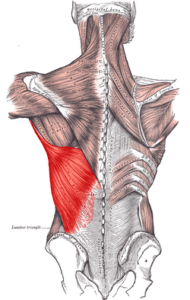
The Elbow Joint
The elbow is a transition joint between our shoulder and hand. This joint consists of the humerus, radius and ulna (see picture below). These bones work together to allow your elbow to bend and straighten, plus turn your palm up and down. These different movements allow your elbow to respond to the shoulder and hand during function: reaching, grasping and driving.
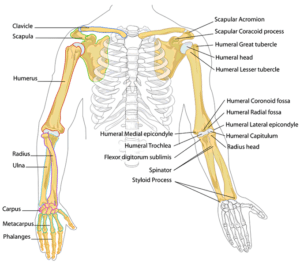
Muscles that Bend and Straighten the Elbow
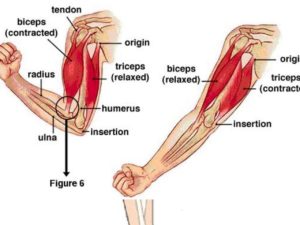 Without getting too technical and picky, the main muscles that bend the elbow are the biceps brachii and brachialis. Commonly, these are called the biceps group. On the back of the arm, the triceps group straightens the elbow. This seems pretty simple, but if either of these muscle groups becomes overloaded with weight or repetition AND your LAT is not activating, some other little forearm muscles will start to help. This is the when your elbow pain starts…
Without getting too technical and picky, the main muscles that bend the elbow are the biceps brachii and brachialis. Commonly, these are called the biceps group. On the back of the arm, the triceps group straightens the elbow. This seems pretty simple, but if either of these muscle groups becomes overloaded with weight or repetition AND your LAT is not activating, some other little forearm muscles will start to help. This is the when your elbow pain starts…
The Forearm Muscles that Try to Help
Most forearm muscles move the wrist, but sometimes these muscles try to help too much at the elbow.
Turn your palm down and trace your forearm all the way to the outside of your elbow. These are your wrist extensors (they move the back of the hand up). And, on the outside of the elbow they form the common extensor tendon. In the picture below, it’s that white/gray portion that anchors on the lateral epicondyle. The lateral epicondyle is that bony piece you feel on the outside of your elbow and when your common extensor tendon has been overworked, it is really painful. This is the infamous tennis elbow…lateral epicondylitis… or outside elbow pain.
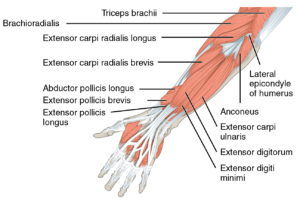
Now, flip your palm up and trace your forearm to the inside of your elbow. These are your wrist flexors (they move your palm up). It’s the same principle as above. These wrist flexors converge on the inside of the elbow to form the common flexor tendon. And, when this tendon is overused, it’s really painful too. This is the infamous golfer’s elbow…medial epicondylitis…inside elbow pain. You get the drift.
The Connection to The Lat: Finally!
Connection One: Biceps and Triceps Lifting
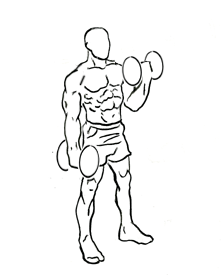 Consider a biceps curl with weights. The weight moves up and down as the elbow bends and straightens. But, here’s the problem: The Lat is highly important during biceps curls. The shoulder blades must be “engaged down the back” and the weight must be under biceps work and Lat stability. If The Lat is not stabilizing the elbow during this exercise, our brain will travel to something in the area. And guess what it usually finds? The common flexor tendon during biceps curls and the common extensor tendon during triceps press. Don’t buy it? Try this.
Consider a biceps curl with weights. The weight moves up and down as the elbow bends and straightens. But, here’s the problem: The Lat is highly important during biceps curls. The shoulder blades must be “engaged down the back” and the weight must be under biceps work and Lat stability. If The Lat is not stabilizing the elbow during this exercise, our brain will travel to something in the area. And guess what it usually finds? The common flexor tendon during biceps curls and the common extensor tendon during triceps press. Don’t buy it? Try this.
Blog Activity
Find an acceptable weight to lift, but something that feels a little heavy. Without considering your posture, curl that weight up and down 8-10 times. Notice that your brain is trying to find stability on the inside of the elbow joint. Now, try to engage your Lat and scapular muscles (squeeze your shoulder blades down your back) and lift the weight. Notice that your body is finding stability in your back and Lat. If you don’t feel it, it’s likely just a new muscle activation for you and you’ll have to practice.
Connection Two: Repetitive Wrist Movement
Imagine yourself outside on a beautiful sunny day…weeding. I’m fairly certain none of us are excited to weed our yard, but most of us have done this task at least once in our life. Weeding is a repetitive hand-gripping, palm-turning, wrist-extending activity that can lead to elbow pain. But it doesn’t have to. Instead of just thinking about using your hand and elbow in an isolated position, get that Lat involved. Meaning, make it a full upper arm motion, almost like a “row” to ensure your brain is finding stability at your trunk and not your elbow.
So, now that we understand the importance of the lat, the following may be a better treatment plan:
- Eccentric strengthening of the wrist muscles to regenerate the painful tendon (chronic tendinopathies have different collagen and require eccentrics)
- Stretching of the wrist, elbow and shoulder to optimize range of motion at every joint
- Latissimus Dorsi exercises that favor the muscles as a stabilizer, not just a mover (Pilates?)
- Good Biomechanics: lifting, repetitive functional tasks that incorporate The Lat as an arm stabilizer
Case Study – Medial Elbow Pain & A New Baby
A 35-year-old mother presented with medial (inside) left elbow pain after the birth of her son. She wasn’t golfing or lifting or pulling weeds, but her common flexor tendon was painful and very tender to the touch. During her evaluation, she stated she loved to hold her son on her left side so she could read and sing to him. After she showed me how she was holding him, it was obvious. She was not using her Lat to stabilize her arm and her elbow tendon was taking on the load! But, with eccentrics, stretching, Lat stability exercises and baby body mechanics, she was able to resolve her tendon pain after 6 weeks.
Thank you for reading! If you enjoyed this post and found it helpful, please share so others can learn too.
© 2017 & Beyond. ALL BLOG CONTENT at duncansportspt.com by Lori Duncan PT
ABOUT THE AUTHOR
 Lori Duncan, DPT, MTC, CPT is a respected Physical Therapist, Manual Therapist and Pilates instructor in Lafayette, CO. Lori is passionate about preventive physical therapy and education and is a nationally recognized presenter. She can be reached at [email protected]. You can also follow Duncan Sports Therapy + Wellness on Facebook & Instagram for more free tips and information.
Lori Duncan, DPT, MTC, CPT is a respected Physical Therapist, Manual Therapist and Pilates instructor in Lafayette, CO. Lori is passionate about preventive physical therapy and education and is a nationally recognized presenter. She can be reached at [email protected]. You can also follow Duncan Sports Therapy + Wellness on Facebook & Instagram for more free tips and information.
References
Bhabra G, Wang A, Ebert JR, et al. Lateral elbow tendinopathy: development of pathophysiology-based treatment algorithm. Orthop J Sports Med. 2016;4(11):2325967116670635


I have pain primarily in my left triceps, which is my stronger tricep. I feel it during extensions, shoulder, and chest work. It’s felt the pain throughout the years I’ve been lifting, but it’s come and gone. This is also the side on which my lat is weaker. So, does this sound like the issue you’re addressing in this article? Thanks.
Hi Josiah,
Yes. A weak lat always causes some issue on the side it’s weak. Shoulder, elbow, wrist. So, I would work on that. The lat not only does extension and adduction, it is a stabilizer. If the body perceives a lack of stability, it uses “other muscles” (in this case your triceps) to stabilize. And, that’s not what the triceps is designed to do. Hope that helps.
This was a very helpful post. I’d developed golfer’s elbow after doing way too many bar muscle ups. This left me unable to do even normal pull ups without a sharp pain in my elbow. I saw a physical therapist, did various forearm stretches and some eccentric exercises almost daily, but the pain persisted, even with several months of rest. After reading your page, I loosened up my lats by foam rolling them and stretching daily. One week later, I really feel much better and can go back to doing pull ups again pain free. Thanks!!
Hi Wilson,
Oh Good! Make sure you strengthen the lat as well as stretch. Thanks for commenting and reading!
Can you please give a list of a few lat exercises you recommend? I am suffering from golfers and tennis elbow